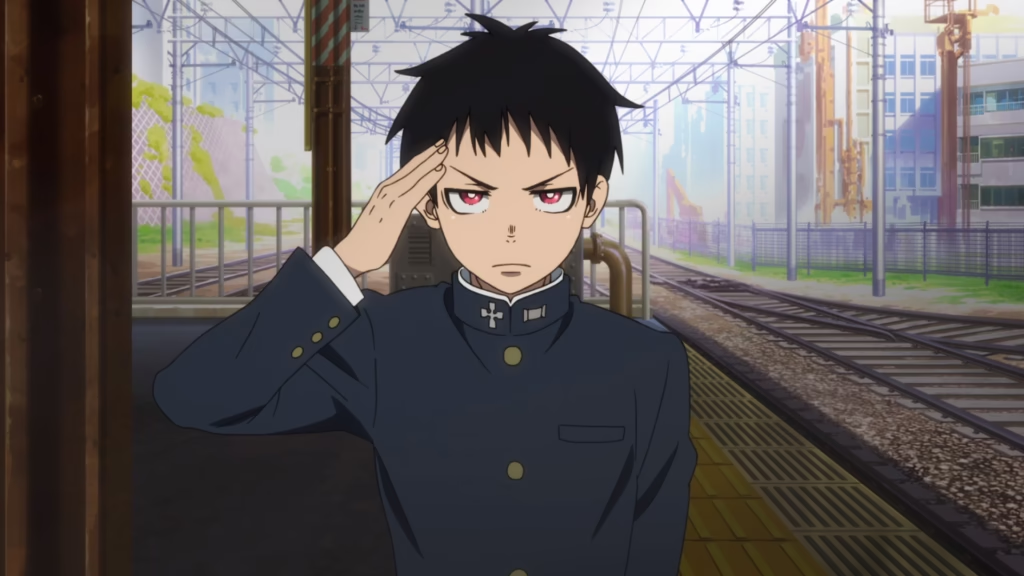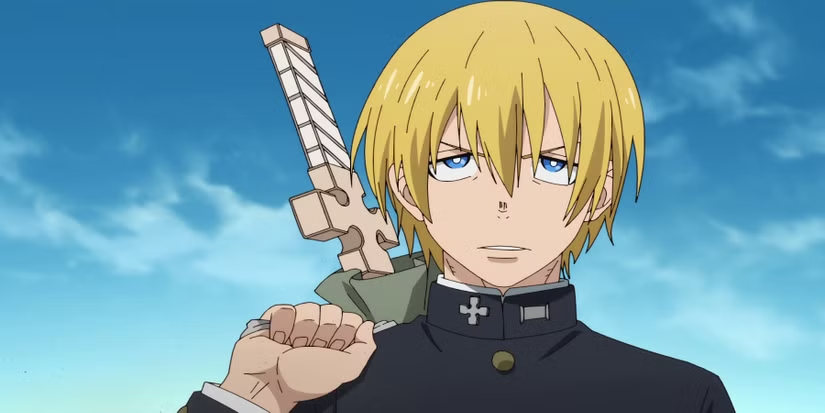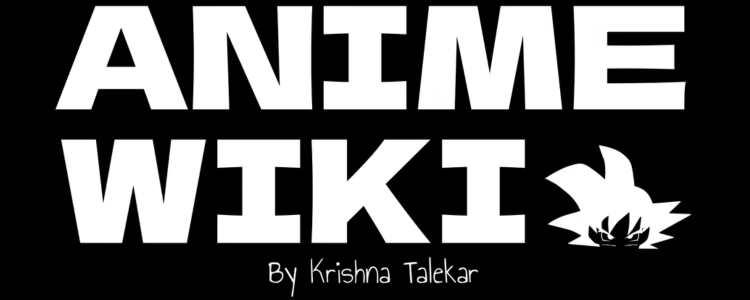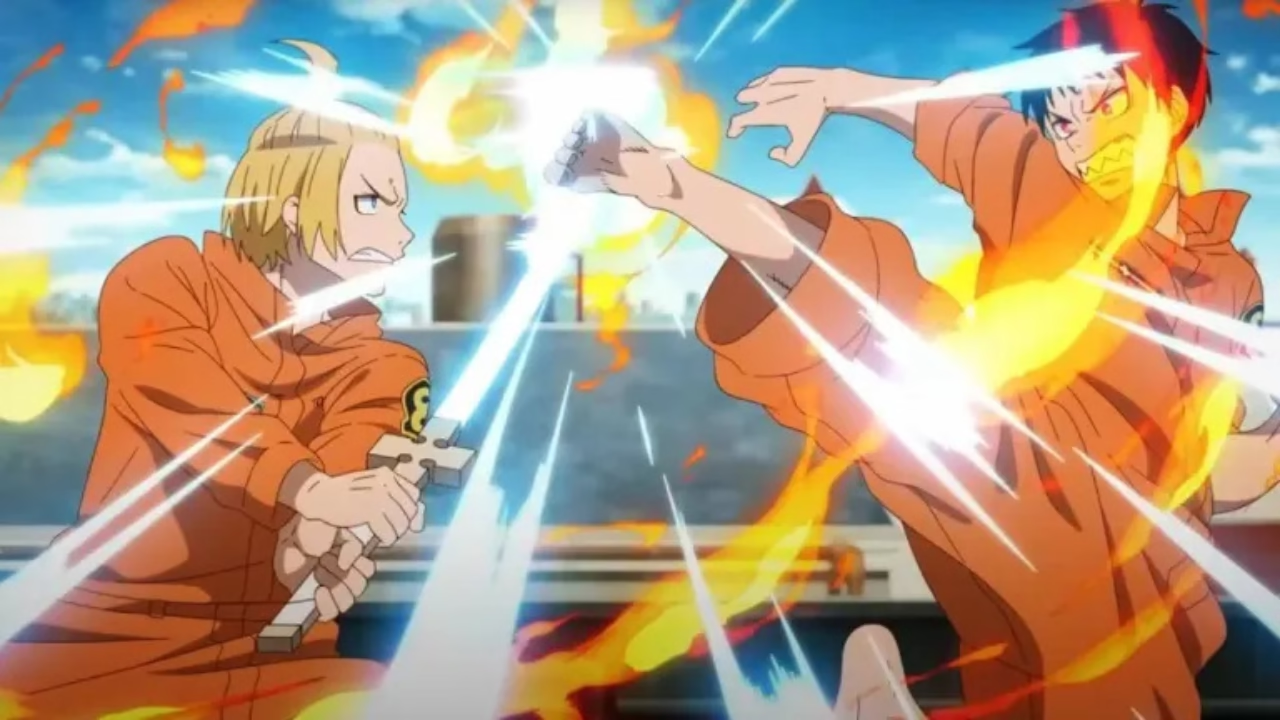Within the blazing world of Fire Force, few dynamics captivate viewers quite like the rivalry between Shinra Kusakabe and Arthur Boyle. Their contrasting elements—fire versus lightning, science versus fantasy, hero versus knight—create a fascinating interplay that drives some of the series’ most memorable moments. The shinra vs arthur dynamic isn’t just about physical combat; it represents a fundamental clash of worldviews and approaches to heroism.
As members of Special Fire Force Company 8, both characters fight for the same cause, yet their methods and motivations couldn’t be more different. This opposition creates not just entertaining battles but also moments of growth and unexpected partnership. Let’s dive into what makes this rivalry so compelling for fans worldwide.
Character Profiles: Shinra Kusakabe & Arthur Boyle
Shinra Kusakabe

Known as “Devil’s Footprints,” Shinra enters the story carrying the burden of his past—namely, the belief that he caused the death of his mother and younger brother during a fire incident. This trauma shapes his unwavering desire to become a hero who saves others from flames. With his distinctive shark-like grin (which often appears at inappropriate moments) and third-generation pyrokinetic abilities focused in his feet, Shinra represents determination and justice.
His ability to ignite his feet allows for incredible speed and aerial maneuvers, earning him the nickname “Devil’s Footprints.” Behind his sometimes awkward social demeanor lies a profoundly moral character with an unshakable sense of right and wrong.
Arthur Boyle

Self-proclaimed “Knight King,” Arthur lives in a world partly of his own making. With an unshakable delusion that he is a knight of legend, Arthur approaches every situation through the lens of chivalry and knightly duty. His third-generation ability manifests as plasma manipulation, which he channels into his “sword” Excalibur—actually just a conventional plasma blade that his mind transforms into something mythical.
What makes Arthur particularly fascinating is that his delusion isn’t just a quirk—it’s the source of his strength. When he believes himself to be in a knightly scenario, his combat abilities increase dramatically. His simple-minded approach to complex problems often yields surprisingly effective results, making him both comic relief and a formidable ally.
In any arthur vs shinra discussion, the contrast between Shinra’s reality-based heroism and Arthur’s fantasy-driven knighthood highlights two very different paths to becoming a warrior.
Power Comparison: Fire and Lightning Collide
Shinra’s “Devil’s Footprints” give him unparalleled mobility in battle. By igniting his feet, he can move at speeds that make him nearly invisible to the naked eye, delivering devastating kicks that combine both concussive force and burning damage. His Rapid ability allows him to accelerate to the point where he appears to teleport, making him one of the most agile fighters in the series. As the story progresses, Shinra unlocks new levels of his power, including the Adolla Burst, which elevates his abilities to nearly divine levels.
Arthur’s plasma manipulation, while seemingly simpler, is equally formidable. His “Excalibur” can cut through almost anything, and his single-minded belief in his knightly status grants him surprising versatility in combat. What makes Arthur particularly dangerous is how his power scales with his conviction—the more certain he is of his knightly role in any given scenario, the more powerful he becomes.
In the shinra vs arthur manga confrontations, we see this power dynamic evolve. Their early skirmishes are mostly competitive sparring, but as the series progresses, both unlock deeper aspects of their abilities. When they fight together rather than against each other, their complementary powers make them nearly unstoppable, with Shinra’s speed creating openings for Arthur’s precision strikes.
What’s fascinating is how their powers reflect their personalities: Shinra’s abilities require constant movement and adaptation, mirroring his journey toward redemption, while Arthur’s power remains steadfast and singular in purpose, reflecting his unwavering (if delusional) knightly mindset.
Ideological Divide: Heroism vs. Chivalry
At the heart of Shinra and Arthur’s rivalry lies a profound ideological difference that shapes everything from their fighting styles to their decision-making processes.
Shinra’s conception of heroism is deeply personal and rooted in his past trauma. For him, being a hero means protecting the innocent and fighting against injustice—a direct response to his inability to save his family. His approach is practical and focused on tangible results: saving lives, defeating enemies, and uncovering the truth. When Shinra declares his intention to become a hero, it’s not just ambition speaking—it’s a solemn vow to never again be powerless in the face of tragedy.
Arthur’s chivalric code, by contrast, exists in a romanticized mental framework. His knightly ideals emphasize honor, direct confrontation, and a black-and-white view of combat. For Arthur, the aesthetic and ritual of battle matter as much as the outcome. He operates according to a strict internal rulebook of knightly behavior, which sometimes leads him to make decisions that seem absurd to others but are perfectly logical within his worldview.
These contrasting ideologies create fascinating tension. When faced with morally ambiguous situations, Shinra typically grapples with complexity while Arthur reduces problems to simpler terms of knightly duty. In one memorable confrontation, Shinra questions the morality of their actions while Arthur simply focuses on defeating the “dragon” before them—his term for any major antagonist.
What makes their ideological clash compelling is that neither approach is presented as wholly superior. Shinra’s nuanced heroism sometimes leads to hesitation, while Arthur’s simplified worldview allows for decisive action. Each has strengths the other lacks, and their growth as characters often comes from absorbing elements of the other’s philosophy.
Key Battles: Notable Shinra vs. Arthur Showdowns
Throughout Fire Force, Shinra and Arthur engage in several memorable confrontations that highlight their evolving relationship and growing powers.
Their first significant clash occurs during training exercises shortly after joining Company 8. What begins as a standard sparring session quickly escalates as both reveal more of their abilities. Shinra relies on his superior speed and agility, while Arthur counters with precision plasma strikes. This initial battle establishes their competitive dynamic while showcasing their potential as fighters.
Perhaps their most iconic confrontation comes during the Asakusa arc, where tension between their approaches to a mission boils over into physical conflict. Shinra advocates for a strategic approach, while Arthur insists on a direct, honorable confrontation with their enemies. Their battle here reveals as much about their psychological states as their combat abilities, with Shinra’s frustration at Arthur’s simplistic worldview meeting Arthur’s disdain for what he perceives as overcomplicated thinking.
As the series progresses, their confrontations evolve from competitive sparring to cooperative combat against increasingly powerful foes. During the Netherworld arc, they find themselves forced to work together against a common enemy, leading to a fascinating display of how their contrasting styles can complement rather than oppose each other.
In each of these encounters, the animation and choreography highlight their distinct approaches: Shinra’s fluid, aerial combat style versus Arthur’s grounded, precise swordsmanship. These differences extend beyond mere aesthetics to reveal fundamental aspects of their characters—Shinra always moving, always seeking, while Arthur stands firm in his convictions.
Shinra vs Arthur: Strengths and Weaknesses
A comprehensive Shinra vs Arthur comparison reveals how their strengths and weaknesses often mirror one another in fascinating ways.
Shinra’s Strengths:
- Unparalleled mobility and speed
- Adaptive fighting style that evolves throughout the series
- Strong moral compass that guides his decisions
- Ability to form meaningful connections with allies
- Progressive growth in controlling his powers
Shinra’s Weaknesses:
- Tendency to overthink situations
- Vulnerability to emotional manipulation due to his past trauma
- Social awkwardness that sometimes affects team dynamics
- Initial difficulty controlling his powers precisely
- Occasionally hesitant when faced with morally complex situations
Arthur’s Strengths:
- Unwavering confidence that borders on invincibility
- Straightforward approach that cuts through complexity
- Immune to psychological warfare due to his delusional confidence
- Precise and devastating attack power
- Ability to maintain focus in chaotic situations
Arthur’s Weaknesses:
- Inflexible thinking that sometimes misses nuance
- Vulnerability when his knightly worldview is challenged
- Difficulty working within team strategies that don’t align with his code
- Limited range of techniques compared to Shinra
- Occasional complete disconnection from reality
What makes their dynamic so compelling is how these strengths and weaknesses interact. Shinra’s overthinking is counterbalanced by Arthur’s straightforward approach. Arthur’s inflexibility finds its complement in Shinra’s adaptability. In combat situations, Shinra’s mobility creates openings that Arthur’s precision can exploit.
Their growth throughout the series often involves recognizing and compensating for their respective weaknesses—Shinra learning to act decisively from Arthur’s example, and Arthur occasionally acknowledging the value of Shinra’s more nuanced perspective.
Symbolism in Their Rivalry
The Shinra-Arthur dynamic serves as a vehicle for exploring several of Fire Force’s central themes. Their rivalry represents the tension between science and faith that permeates the series, with Shinra’s more grounded approach contrasting with Arthur’s mystical worldview. This mirrors the larger conflict between scientific understanding of Infernals and the religious interpretation offered by the Holy Sol Temple.
Their elemental associations further deepen this symbolism. Shinra’s fire represents transformation and constant change—fitting for a character seeking to redefine himself beyond his traumatic past. Arthur’s plasma, often depicted as lightning-like, represents singular purpose and illumination—appropriate for a character who sees the world in stark, simplified terms.
Their relationship also embodies the series’ exploration of perception versus reality. Just as the truth about Infernals remains contested throughout Fire Force, Shinra and Arthur represent two different ways of perceiving and interacting with the world. Shinra seeks objective truth, while Arthur creates his own reality—yet both approaches yield results, suggesting that truth itself may be more malleable than it appears.
Fan theories often point to how their rivalry represents different coping mechanisms for trauma. Shinra confronts his past directly, while Arthur has constructed an elaborate alternative reality. Neither approach is presented as inherently superior, suggesting that different paths to healing are valid for different individuals.
How Fans See Shinra vs Arthur
The rivalry between these two characters has sparked endless debates among Fire Force enthusiasts, particularly among anime fans in the U.S. Online forums, Reddit discussions, and Twitter polls regularly pit these characters against each other, with fans dividing themselves into Team Shinra or Team Arthur based on which character’s approach they find more compelling.
Fan polls typically show a slight preference for Shinra among Western audiences, likely due to his more traditionally heroic narrative and clear character development. Arthur, however, maintains a dedicated fanbase who appreciate his unwavering commitment to his knightly code and his scene-stealing comedic moments.
The meme culture surrounding their rivalry is particularly vibrant, with Arthur’s delusional confidence becoming a template for numerous internet jokes. One popular meme format contrasts Shinra’s complex internal monologues with Arthur’s simple “knight solves problem” approach, highlighting the comedic aspect of their different worldviews.
Cosplay communities have embraced both characters with equal enthusiasm. At U.S. anime conventions, Shinra cosplayers often demonstrate his distinctive grin and dynamic poses, while Arthur cosplayers commit fully to his knightly persona, sometimes carrying elaborate versions of Excalibur.
Fan fiction exploring alternative scenarios for their rivalry is abundant, with many writers exploring “what if” situations: What if Arthur was the protagonist? What if Shinra embraced Arthur’s knightly worldview? These creative explorations demonstrate how deeply fans connect with the dynamic between these characters.
Conclusion: Two Sides of the Same Flame
The shinra vs arthur dynamic ultimately transcends simple rivalry to become something more profound: a representation of two complementary approaches to heroism. While their methods and mindsets differ dramatically, their core values—protection of the innocent and standing against evil—remain aligned.
Throughout Fire Force, their growth is often catalyzed by each other, with Shinra occasionally adopting Arthur’s unwavering confidence and Arthur sometimes acknowledging the complexity that Shinra navigates. Their rivalry pushes both to become stronger, not just physically but as fully realized individuals with distinct philosophies.
What makes their relationship so compelling is that neither is presented as the “correct” approach. Fire Force suggests that the world needs both types of heroes: those who question and adapt like Shinra, and those who stand firm in their convictions like Arthur. Their friction creates not just entertaining conflict but a more nuanced exploration of heroism itself.
As the series progresses, their initial rivalry evolves into a partnership that maintains their differences while acknowledging their shared goals. This evolution mirrors the larger theme of Fire Force: that unity doesn’t require uniformity, and that different paths can lead to the same destination.
In the burning world of Fire Force, Shinra and Arthur represent two different ways to face the flames—and the series is richer for including both.
FAQs About Shinra vs Arthur
-
Who is stronger: Shinra or Arthur?
This question doesn’t have a straightforward answer as their powers scale differently throughout the series. While Shinra demonstrates more raw power and speed, especially after awakening his Adolla Burst, Arthur’s abilities increase dramatically when his knightly delusions are at their strongest. In direct confrontations, they appear evenly matched, with victory often depending on circumstance rather than inherent superiority.
-
Why does Arthur always think he’s a knight?
Arthur’s knightly delusion appears to be a combination of childhood influences and a psychological coping mechanism. The series hints that his immersion in knight stories as a child, combined with a possible traumatic event, led him to construct this alternative identity. Interestingly, his delusion isn’t portrayed as purely negative—it’s the source of his strength and confidence, suggesting it may be a form of adaptive psychology rather than simple madness.
-
How many times have Shinra and Arthur fought?
Throughout the Fire Force series, Shinra and Arthur engage in approximately five significant confrontations, ranging from serious sparring matches to full-fledged battles driven by ideological differences. However, they collaborate in combat far more often than they oppose each other, with dozens of instances where they fight alongside one another against common enemies.
-
Who wins in Shinra vs Arthur in the manga?
In the manga, their confrontations typically end in stalemates or are interrupted before a clear winner emerges. Their most conclusive battle occurs during the Asakusa arc, where Shinra gains a slight upper hand but the fight ends with mutual respect rather than a definitive victory. As the manga progresses, their rivalry becomes less about winning against each other and more about pushing each other to improve.
-
What episode does Shinra fight Arthur?
The first significant fight between Shinra and Arthur occurs in Episode 4 of the anime, titled “The Hero and the Princess.” This training session quickly escalates beyond a simple sparring match as both demonstrate their abilities. Their rivalry continues throughout the series, with notable confrontations in Episodes 11, 18, and 32, each showing their evolving relationship and growing powers.


Leave a Reply